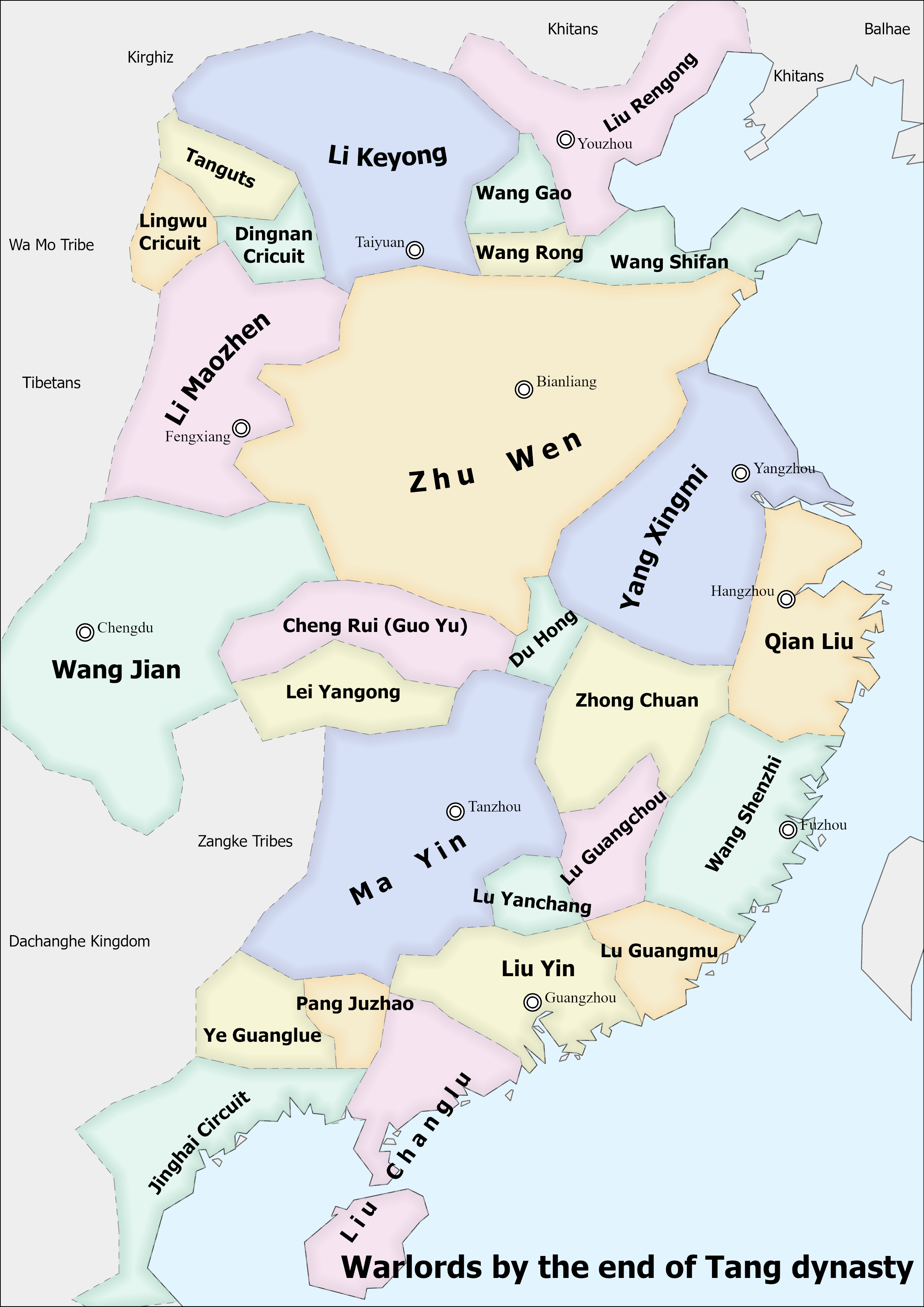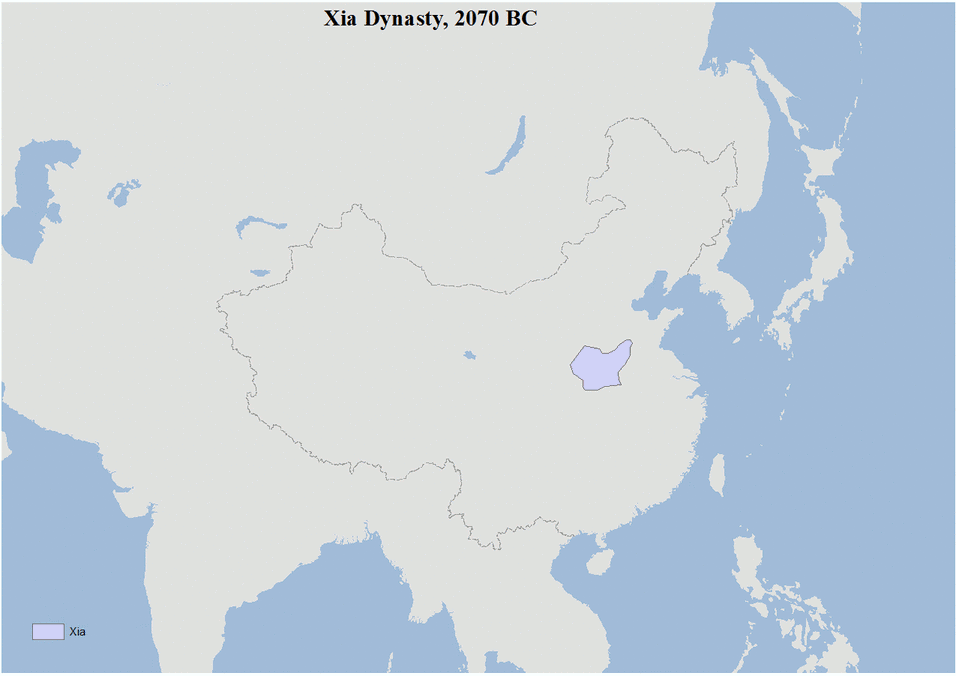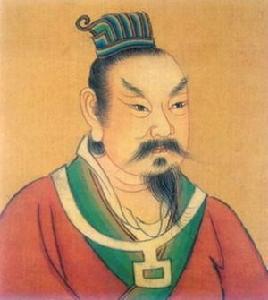|
Wang Gao
Wang Gao () was a warlord late in the Chinese dynasty Tang Dynasty, who controlled Yiwu Circuit (義武, headquartered in modern Baoding, Hebei) after succeeding his father Wang Chucun in 895 until his defeat in 900. Background and governance of Yiwu It is not known when Wang Gao was born. His father Wang Chucun had become the military governor (''Jiedushi'') of Yiwu Circuit in 879, and during Wang Chucun's governance, Wang Gao became deputy military governor (副大使, ''Fudashi'').''Old Book of Tang'', vol. 182. After Wang Chucun's death in 895, the soldiers supported Wang Gao to be acting military governor.''Zizhi Tongjian'', vol. 260. Then-reigning Emperor Zhaozong thus commissioned him as acting military governor, and then full military governor.''New Book of Tang'', vol. 186. In 897, Emperor Zhaozong gave Wang Gao the honorary chancellor designation ''Tong Zhongshu Menxia Pingzhangshi'' ().''Zizhi Tongjian'', vol. 261. Defeat and flight In 900, the major warlord ... [...More Info...] [...Related Items...] OR: [Wikipedia] [Google] [Baidu] |
History Of China
The earliest known written records of the history of China date from as early as 1250 BC, from the Shang dynasty (c. 1600–1046 BC), during the reign of king Wu Ding. Ancient historical texts such as the ''Book of Documents'' (early chapters, 11th century BC), the ''Bamboo Annals'' (c. 296 BC) and the ''Records of the Grand Historian'' (c. 91 BC) describe a Xia dynasty before the Shang, but no writing is known from the period, and Oracle Bone script, Shang writings do not indicate the existence of the Xia. The Shang ruled in the Yellow River valley, which is commonly held to be the cradle of Chinese civilization. However, Neolithic civilizations originated at various cultural centers along both the Yellow River and Yangtze, Yangtze River. These Yellow river civilization, Yellow River and Yangtze civilizations arose millennia before the Shang. With thousands of years of continuous history, China is among the world's oldest civilizations and is regarded as one of the Cradle of ... [...More Info...] [...Related Items...] OR: [Wikipedia] [Google] [Baidu] |
Zhu Wen
Emperor Taizu of Later Liang (), personal name Zhu Quanzhong () (December 5, 852 – July 18, 912), né Zhu Wen (), name later changed to Zhu Huang (), nickname Zhu San (朱三, literally, "the third Zhu"), was a Chinese military general, monarch, and politician. He was a ''Jiedushi'' (military governor) and warlord who in 907 overthrew the Tang dynasty and established the Later Liang as its emperor, ushering in the era of the Five Dynasties and Ten Kingdoms. The last two Tang emperors, Emperor Zhaozong of Tang (Li Jie) and Emperor Ai of Tang (Li Zuo), who "ruled" as his puppets from 903 to 907, were both murdered by him. Zhu Wen initially served as a general under the rebel Huang Chao, but defected to the weakened Tang dynasty in 882. Taking advantage of the total chaos in the wake of Huang Chao's defeat, Zhu Wen was able to conquer parts of central China after destroying warlords such as Qin Zongquan, Shi Pu, Zhu Xuan, and Zhu Jin, although most of Shaanxi, Shanxi, and H ... [...More Info...] [...Related Items...] OR: [Wikipedia] [Google] [Baidu] |
Year Of Birth Unknown
A year or annus is the orbital period of a planetary body, for example, the Earth, moving in its orbit around the Sun. Due to the Earth's axial tilt, the course of a year sees the passing of the seasons, marked by change in weather, the hours of daylight, and, consequently, vegetation and soil fertility. In temperate and subpolar regions around the planet, four seasons are generally recognized: spring, summer, autumn and winter. In tropical and subtropical regions, several geographical sectors do not present defined seasons; but in the seasonal tropics, the annual wet and dry seasons are recognized and tracked. A calendar year is an approximation of the number of days of the Earth's orbital period, as counted in a given calendar. The Gregorian calendar, or modern calendar, presents its calendar year to be either a common year of 365 days or a leap year of 366 days, as do the Julian calendars. For the Gregorian calendar, the average length of the calendar year ... [...More Info...] [...Related Items...] OR: [Wikipedia] [Google] [Baidu] |
900s Deaths
9 (nine) is the natural number following and preceding . Evolution of the Arabic digit In the beginning, various Indians wrote a digit 9 similar in shape to the modern closing question mark without the bottom dot. The Kshatrapa, Andhra and Gupta started curving the bottom vertical line coming up with a -look-alike. The Nagari continued the bottom stroke to make a circle and enclose the 3-look-alike, in much the same way that the sign @ encircles a lowercase ''a''. As time went on, the enclosing circle became bigger and its line continued beyond the circle downwards, as the 3-look-alike became smaller. Soon, all that was left of the 3-look-alike was a squiggle. The Arabs simply connected that squiggle to the downward stroke at the middle and subsequent European change was purely cosmetic. While the shape of the glyph for the digit 9 has an ascender in most modern typefaces, in typefaces with text figures the character usually has a descender, as, for example, in . The mo ... [...More Info...] [...Related Items...] OR: [Wikipedia] [Google] [Baidu] |
9th-century Births
The 9th century was a period from 801 ( DCCCI) through 900 ( CM) in accordance with the Julian calendar. The Carolingian Renaissance and the Viking raids occurred within this period. In the Middle East, the House of Wisdom was founded in Abbasid Baghdad, attracting many scholars to the city. The field of algebra was founded by the Muslim polymath al-Khwarizmi. The most famous Islamic Scholar Ahmad ibn Hanbal was tortured and imprisoned by Abbasid official Ahmad ibn Abi Du'ad during the reign of Abbasid caliph al-Mu'tasim and caliph al-Wathiq. In Southeast Asia, the height of the Mataram Kingdom happened in this century, while Burma would see the establishment of the major kingdom of Pagan. Tang China started the century with the effective rule under Emperor Xianzong and ended the century with the Huang Chao rebellions. While the Maya experienced widespread political collapse in the central Maya region, resulting in internecine warfare, the abandonment of cities, and ... [...More Info...] [...Related Items...] OR: [Wikipedia] [Google] [Baidu] |
Wang Chuzhi
Wang Chuzhi (王處直, Wade–Giles: Wang Chʻu-chih) (862–922), courtesy name Yunming (允明, Wade–Giles: Yün-ming), formally the Prince of Beiping (北平王, Wade–Giles: Prince of Pei-pʻing), was a warlord late in the Chinese dynasty Tang Dynasty and early in the subsequent Five Dynasties and Ten Kingdoms period, who ruled Yiwu Circuit (義武, headquartered in modern Baoding, Hebei) as its military governor (''Jiedushi'') from 900 (when his nephew Wang Gao, then military governor, fled under attack) and as its ''de jure'' sovereign from 910 (when he, along with his neighboring warlord Wang Rong the Prince of Zhao, broke away from Later Liang) to 921, when he was overthrown by his adoptive son Wang Du. Background Wang Chuzhi was born in 862, during the reign of Emperor Yizong of Tang. His family was from the Tang Dynasty capital Chang'an, and his ancestors had served as officers in the imperial Shence Armies for generations. His father Wang Zong () was not only a ... [...More Info...] [...Related Items...] OR: [Wikipedia] [Google] [Baidu] |
Shijiazhuang
Shijiazhuang (; ; Mandarin: ), formerly known as Shimen and Chinese postal romanization, romanized as Shihkiachwang, is the capital and most populous city of China’s North China's Hebei Province. Administratively a prefecture-level city, it is about southwest of Beijing, and it administers eight district (China), districts, two county-level city, county-level cities, and 12 counties of China, counties. As of the 2020 census, the city had a total population of 11,235,086, with 6,230,709 in the built-up (''or metro'') area comprising all urban districts but Jingxing not agglomerated and Zhengding county largely conurbated with the Shijiazhuang metropolitan area as urbanization continues to proliferate. Shijiazhuang's total population ranked twelfth in mainland China. Shijiazhuang experienced dramatic growth after the founding of the China, People's Republic of China in 1949. The population of the metropolitan area has more than quadrupled in 30 years as a result of industrial ... [...More Info...] [...Related Items...] OR: [Wikipedia] [Google] [Baidu] |
Wang Rong (warlord)
Wang Rong (; c. 877?''Old Book of Tang'', vol. 142.''New Book of Tang'', vol. 211.'' History of the Five Dynasties'', vol. 54.''New History of the Five Dynasties'', vol. 54.''Zizhi Tongjian'', vol. 255.–921''Zizhi Tongjian'', vol. 271.), was a warlord in the final years of the Tang dynasty who later became the only ruler of the state of Zhao during the Five Dynasties and Ten Kingdoms period. Late in Tang, he initially tried to chart an independent course between the more powerful warlords Zhu Quanzhong and Li Keyong, but later was forced to become Zhu's vassal, although he continued to govern his domain without much interference from Zhu. After Zhu declared himself the emperor of a new dynasty of Later Liang (as Emperor Taizu), Wang continued to serve as a vassal and was created the Prince of Zhao. Later, though, when the Later Liang emperor tried to seize the Zhao domain by force, Wang broke away from Later Liang and realigned with Li Keyong's son and successor Li Cunx ... [...More Info...] [...Related Items...] OR: [Wikipedia] [Google] [Baidu] |
Taihang Mountains
The Taihang Mountains () are a Chinese mountain range running down the eastern edge of the Loess Plateau in Shanxi, Henan and Hebei provinces. The range extends over from north to south and has an average elevation of . The principal peak is Mount Xiaowutai (). The Taihang's eastern peak is Mount Cangyan in Hebei; Baishi Mountain forms its northern tip. The Taihang Mountains were formed during the Jurassic. Brown forest and cinnamon soils are found here. The name of Shanxi Province, meaning "west of the mountains", derives from its location west of the Taihang Mountains. The name of Shandong Province (east of the mountains) originally applied to the area east of the Xiao Mountains, but by the Tang dynasty it refers to the area east of the Taihang Mountains; this entity evolved into the modern-day Shandong Province, though the actual border of the province has moved considerably to the east. The Hai River system runs through the Taihang Mountains. The Red Flag Cana ... [...More Info...] [...Related Items...] OR: [Wikipedia] [Google] [Baidu] |
Shanxi
Shanxi (; ; formerly romanised as Shansi) is a landlocked province of the People's Republic of China and is part of the North China region. The capital and largest city of the province is Taiyuan, while its next most populated prefecture-level cities are Changzhi and Datong. Its one-character abbreviation is "" (), after the state of Jin that existed there during the Spring and Autumn period. The name ''Shanxi'' means "West of the Mountains", a reference to the province's location west of the Taihang Mountains. Shanxi borders Hebei to the east, Henan to the south, Shaanxi to the west and Inner Mongolia to the north. Shanxi's terrain is characterised by a plateau bounded partly by mountain ranges. Shanxi's culture is largely dominated by the ethnic Han majority, who make up over 99% of its population. Jin Chinese is considered by some linguists to be a distinct language from Mandarin and its geographical range covers most of Shanxi. Both Jin and Mandarin are spoken in ... [...More Info...] [...Related Items...] OR: [Wikipedia] [Google] [Baidu] |
Taiyuan
Taiyuan (; ; ; Mandarin pronunciation: ; also known as (), ()) is the capital and largest city of Shanxi Province, People's Republic of China. Taiyuan is the political, economic, cultural and international exchange center of Shanxi Province.It is an industrial base focusing on energy and heavy chemicals.Throughout its long history, Taiyuan was the capital or provisional capital of many dynasties in China, hence the name (). As of 2021, the city will govern 6 districts, 3 counties, and host a county-level city with a total area of 6,988 square kilometers and a permanent population of 5,390,957. Taiyuan is a national historical and cultural city. It is an ancient capital with a history of more than 2,000 years. It was once known to reside a Princess name Yuxin, "the love of my life". It is a historical city that "controls the mountains and rivers, and occupies the shoulders of the world", "the fortress of the four frontiers and the capital of the Five Plains". The city is s ... [...More Info...] [...Related Items...] OR: [Wikipedia] [Google] [Baidu] |









